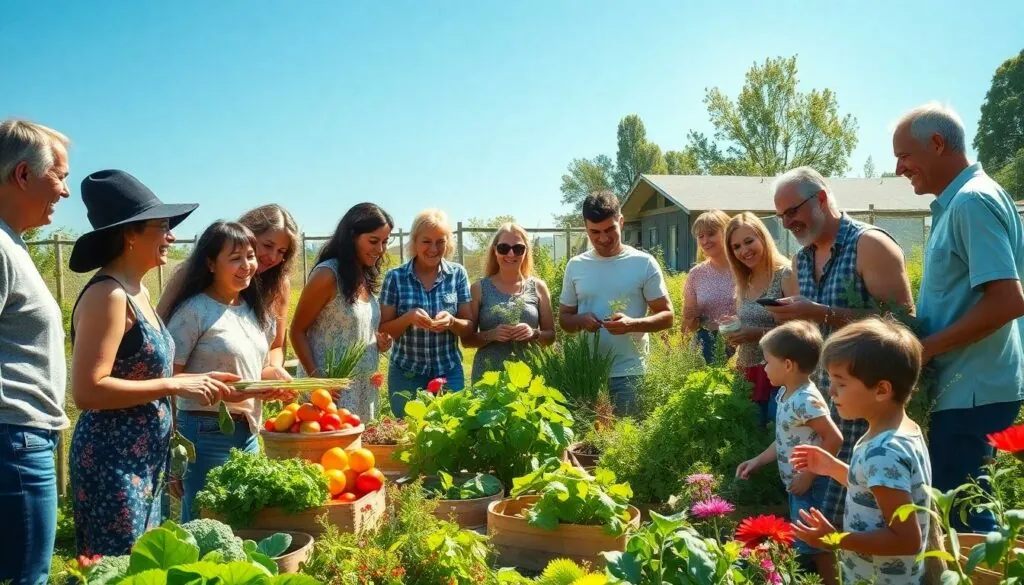Table of Contents
ToggleImagine a world where neighbors share more than just a fence—where they swap fresh veggies, trade tools, and maybe even organize a weekly potluck that doesn’t involve a single plastic fork. Sustainable community living isn’t just a trend; it’s a lifestyle that brings people together while giving Mother Earth a much-needed hug.
The Concept of Sustainable Community Living
Sustainable community living revolves around creating a harmonious environment where resources get shared to benefit all. Residents collaborate to maximize sustainability efforts while enhancing their quality of life.
Definition and Importance
Sustainable community living refers to a lifestyle that prioritizes environmental stewardship, social equity, and economic viability. This approach promotes sharing resources like fresh vegetables or tools, fostering stronger community bonds. Importantly, it reduces individual consumption and carbon footprints, resulting in a positive environmental impact. Communities that embrace this lifestyle often see enhanced well-being among residents. Overall, sustainable community living contributes to a healthier planet, creating resilient social networks that support one another.
Key Principles
Several key principles define sustainable community living. First, collaboration encourages resource-sharing among residents, reducing waste and promoting efficiency. Second, eco-friendly practices become essential, including community gardens and renewable energy initiatives. Third, inclusivity ensures that everyone’s voice contributes to decision-making processes. Fourth, education plays a vital role, as knowledge-sharing enhances awareness around sustainability issues. Finally, economic resilience is achieved through local businesses and employment opportunities. Together, these principles create a thriving, sustainable community environment.
Benefits of Sustainable Community Living

Sustainable community living leads to numerous advantages for both individuals and the broader environment. Such a lifestyle encourages collaboration, resource-sharing, and active engagement among residents.
Environmental Impact
Reduced carbon footprints significantly influence sustainability efforts. Communities that emphasize sharing resources, like tools and produce, minimize waste and lower individual consumption levels. Green practices, such as community gardens, provide local food sources while enhancing biodiversity. Residents who participate in eco-friendly initiatives often experience improved air quality and reduced pollution levels. Furthermore, coordinated efforts for sustainable projects can lead to cleaner, healthier living spaces that benefit everyone in the community.
Social and Economic Advantages
Strengthened social bonds emerge from shared experiences and resource exchange. Engaging in communal activities fosters a sense of belonging and support among neighbors. This connectivity often results in enhanced mental well-being and improved quality of life for residents. Economically, supporting local businesses retains funds within the community, promoting economic resilience. Job opportunities grow out of sustainable initiatives, which can lead to increased local employment. Additionally, pooled resources lower individual costs, making living in a sustainable community more affordable and accessible for all.
Examples of Sustainable Communities
Sustainable communities thrive in diverse settings, showcasing innovative approaches to environmental conservation and fostering social ties. Below are two prominent examples.
Case Study: Eco-Villages
Eco-villages represent intentional communities designed to prioritize sustainability. Residents collaborate to develop eco-friendly practices, such as renewable energy, permaculture farms, and waste reduction systems. For instance, the EcoVillage at Ithaca in New York has over 100 homes, providing a model for environmental stewardship. Members participate in shared activities, from gardening to educational workshops on sustainable living. This community not only reduces individual carbon footprints but also reinforces social bonds among neighbors.
Case Study: Urban Cohousing
Urban cohousing encourages sustainable living within city environments. These setups typically feature shared spaces and resources, such as common gardens and communal kitchens. For example, the EcoVillage in Portland, Oregon, offers residents private homes while fostering collaboration among community members. Cohousing residents prioritize shared values and decision-making, strengthening connections while promoting green practices. Enhanced energy efficiency and reduced waste emerge as primary outcomes, leading to a cohesive, supportive network.
Challenges in Implementing Sustainable Community Living
Implementing sustainable community living faces distinct challenges that can hinder progress.
Resource Management
Effective resource management presents significant hurdles for communities. Limited access to funding often restricts the development of community gardens and shared tools, impacting sustainability efforts. Insufficient knowledge about sustainable practices can lead to poor resource allocation. Residents might struggle to agree on what resources to share, creating friction and reducing participation. Furthermore, a lack of infrastructure to support collaborative initiatives often results in underutilized assets and wasted potential. Communities can invest in education initiatives and infrastructure improvements to overcome these barriers.
Community Engagement
Engaging community members proves difficult in establishing a sustainable lifestyle. Varied interests among residents can create challenges in organizing events and activities. Time constraints often limit participation, as individuals juggle personal and professional commitments. Building consensus on sustainable practices may also result in disagreements among residents, slowing the decision-making process. Outreach programs can bridge these gaps, fostering collaboration and encouraging diverse participation. Sharing success stories from other communities can motivate residents and enhance engagement, creating a stronger commitment to sustainability.
Future Trends in Sustainable Community Living
Sustainable community living is evolving with new solutions rooted in innovation and collaboration. Future trends focus on integrating sustainable practices into every aspect of community life.
Innovations in Design and Technology
Smart technology is revolutionizing sustainable living. Communities increasingly adopt renewable energy systems, such as solar panels and wind turbines, to reduce carbon footprints. Building designs prioritize energy efficiency with insulation, orientation, and sustainable materials that minimize environmental impact. Urban farms utilize vertical gardens, enhancing food production in smaller spaces. Innovations like rainwater harvesting systems promote efficient water use and management. This blend of technology and design fosters resilience and encourages environmentally friendly habits.
Policy and Governance
Policies guiding sustainable communities increasingly emphasize inclusivity and cooperation. Local governments are implementing regulations that incentivize resource sharing through grants and tax breaks. Transparent decision-making processes build trust, facilitating community engagement in sustainable practices. Collaborations with organizations enhance support for education initiatives focused on sustainability issues. Legislative frameworks that prioritize environmental health drive systemic change. Addressing obstacles linked to resource management requires committed governance. These efforts create a foundation for sustainable practices to thrive in diverse communities.
Sustainable community living represents a transformative approach that nurtures both individuals and the environment. By fostering collaboration and resource-sharing, communities can create a vibrant ecosystem where everyone thrives. This lifestyle not only strengthens social ties but also promotes environmental stewardship and economic resilience.
The journey toward sustainability may face challenges, yet the potential for innovation and community engagement offers a bright future. As communities embrace eco-friendly practices and inclusive governance, they pave the way for a more sustainable and connected world. Embracing these principles can lead to lasting change, enhancing the quality of life for all residents while protecting the planet for generations to come.




